CHCECE003 & CHCECE005: Early Childhood Education and Care Project
VerifiedAdded on 2023/06/17
|17
|4392
|124
Project
AI Summary
This project solution covers key aspects of early childhood education and care, addressing the requirements of CHCECE003 and CHCECE005. It details the physical facilities of a childcare service, nutritional provisions, hygiene practices, and safety procedures. The project also explores strategies for managing upset children, toilet training, and creating a comfortable environment for children and parents. Furthermore, it discusses the transition from home to care, sleep routines, infection control, nappy changing, and healthy eating habits for babies and toddlers. The document emphasizes the importance of educators developing positive relationships with children and maintaining a supportive and safe environment. Desklib provides this assignment as a resource for students, alongside a wealth of other study materials including past papers and solved assignments.
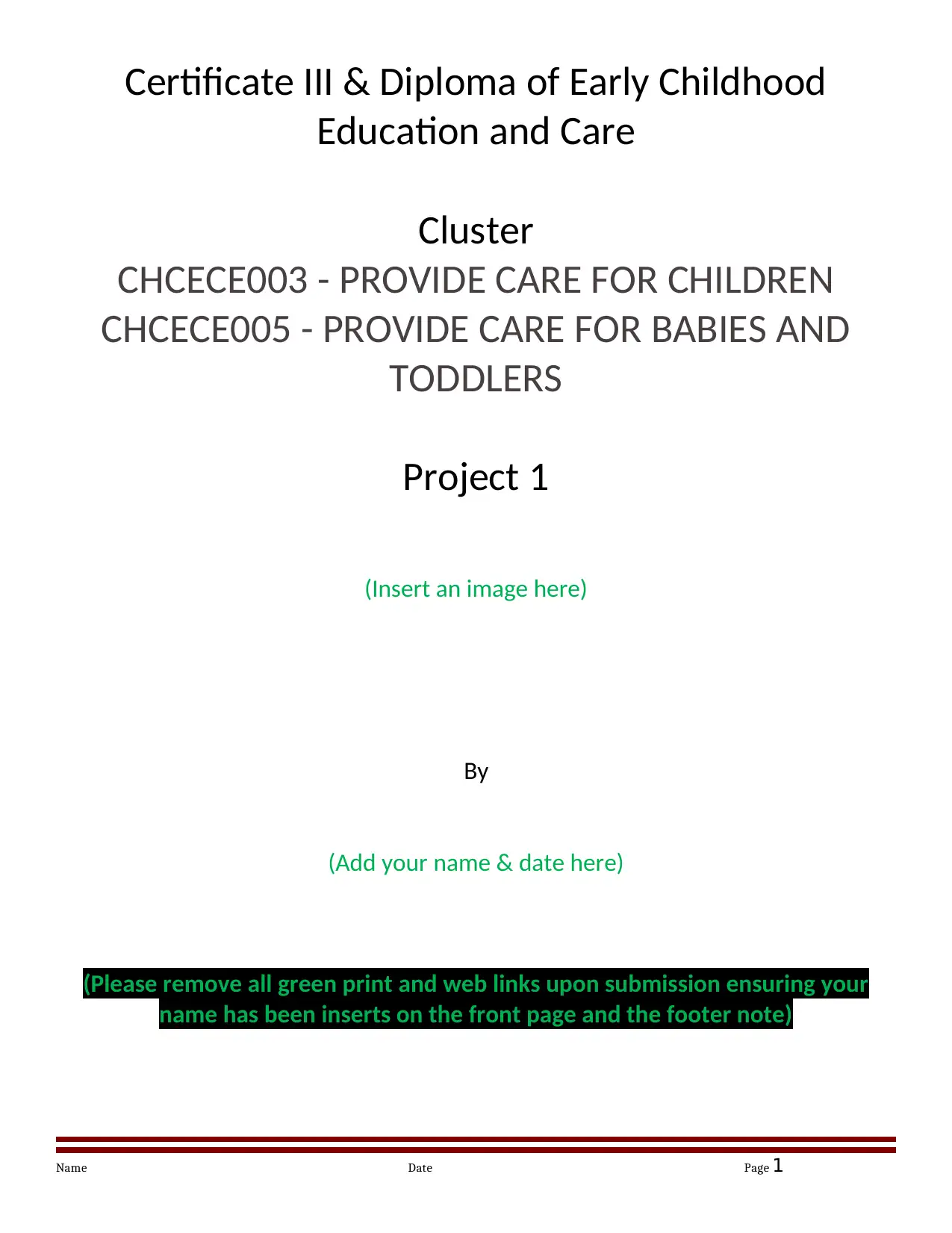
Certificate III & Diploma of Early Childhood
Education and Care
Cluster
CHCECE003 - PROVIDE CARE FOR CHILDREN
CHCECE005 - PROVIDE CARE FOR BABIES AND
TODDLERS
Project 1
(Insert an image here)
By
(Add your name & date here)
(Please remove all green print and web links upon submission ensuring your
name has been inserts on the front page and the footer note)
Name Date Page 1
Education and Care
Cluster
CHCECE003 - PROVIDE CARE FOR CHILDREN
CHCECE005 - PROVIDE CARE FOR BABIES AND
TODDLERS
Project 1
(Insert an image here)
By
(Add your name & date here)
(Please remove all green print and web links upon submission ensuring your
name has been inserts on the front page and the footer note)
Name Date Page 1
Paraphrase This Document
Need a fresh take? Get an instant paraphrase of this document with our AI Paraphraser
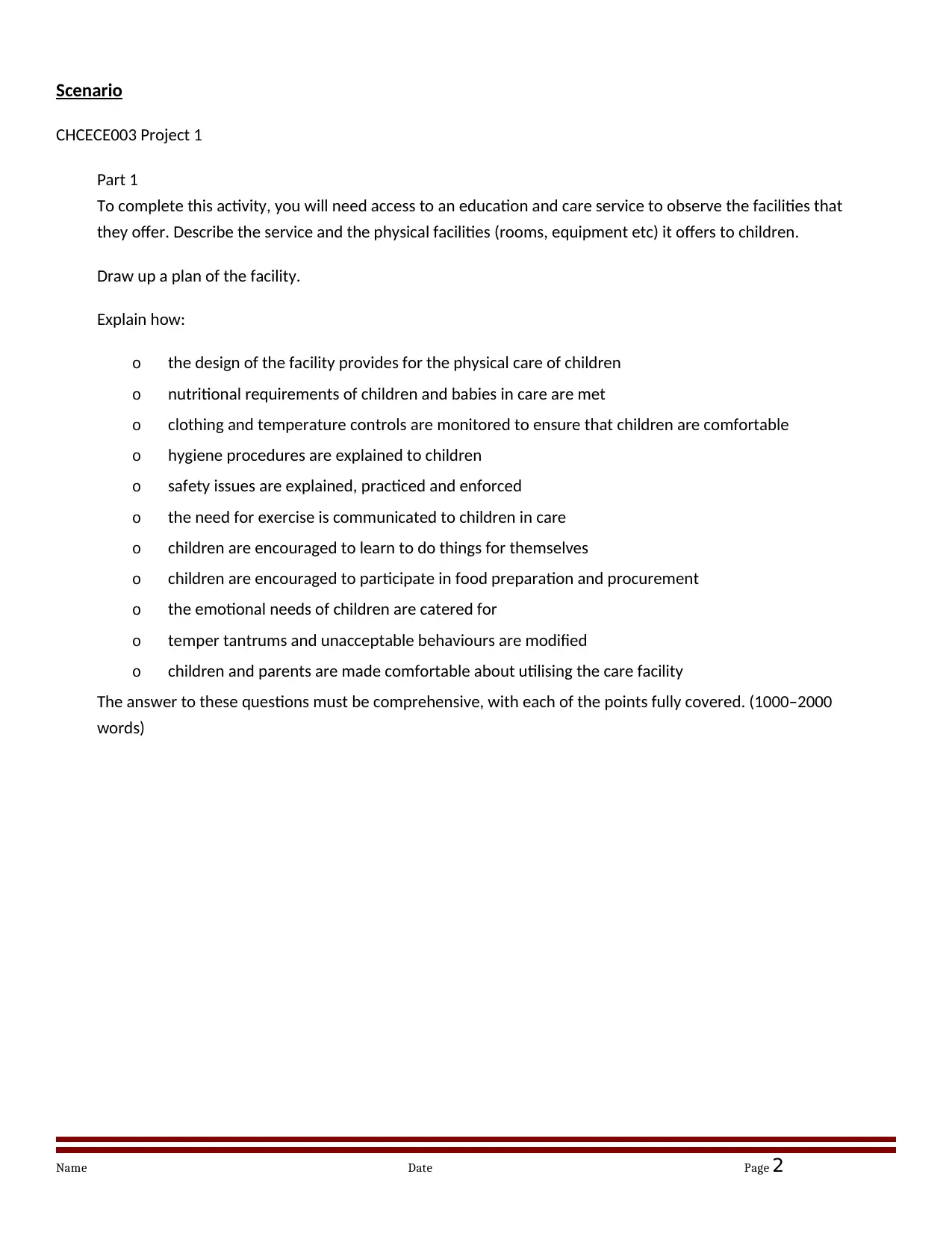
Scenario
CHCECE003 Project 1
Part 1
To complete this activity, you will need access to an education and care service to observe the facilities that
they offer. Describe the service and the physical facilities (rooms, equipment etc) it offers to children.
Draw up a plan of the facility.
Explain how:
o the design of the facility provides for the physical care of children
o nutritional requirements of children and babies in care are met
o clothing and temperature controls are monitored to ensure that children are comfortable
o hygiene procedures are explained to children
o safety issues are explained, practiced and enforced
o the need for exercise is communicated to children in care
o children are encouraged to learn to do things for themselves
o children are encouraged to participate in food preparation and procurement
o the emotional needs of children are catered for
o temper tantrums and unacceptable behaviours are modified
o children and parents are made comfortable about utilising the care facility
The answer to these questions must be comprehensive, with each of the points fully covered. (1000–2000
words)
Name Date Page 2
CHCECE003 Project 1
Part 1
To complete this activity, you will need access to an education and care service to observe the facilities that
they offer. Describe the service and the physical facilities (rooms, equipment etc) it offers to children.
Draw up a plan of the facility.
Explain how:
o the design of the facility provides for the physical care of children
o nutritional requirements of children and babies in care are met
o clothing and temperature controls are monitored to ensure that children are comfortable
o hygiene procedures are explained to children
o safety issues are explained, practiced and enforced
o the need for exercise is communicated to children in care
o children are encouraged to learn to do things for themselves
o children are encouraged to participate in food preparation and procurement
o the emotional needs of children are catered for
o temper tantrums and unacceptable behaviours are modified
o children and parents are made comfortable about utilising the care facility
The answer to these questions must be comprehensive, with each of the points fully covered. (1000–2000
words)
Name Date Page 2
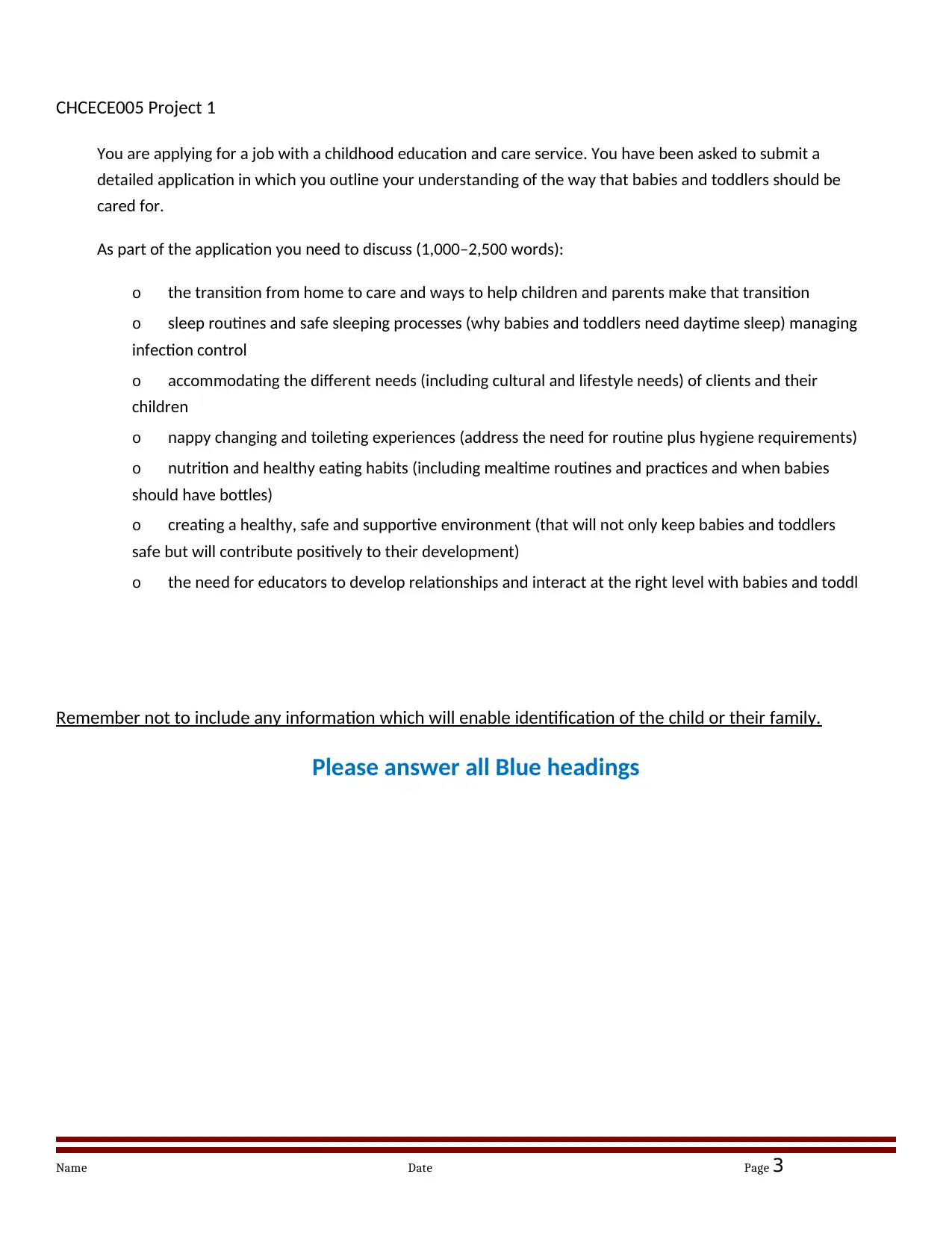
CHCECE005 Project 1
You are applying for a job with a childhood education and care service. You have been asked to submit a
detailed application in which you outline your understanding of the way that babies and toddlers should be
cared for.
As part of the application you need to discuss (1,000–2,500 words):
o the transition from home to care and ways to help children and parents make that transition
o sleep routines and safe sleeping processes (why babies and toddlers need daytime sleep) managing
infection control
o accommodating the different needs (including cultural and lifestyle needs) of clients and their
children
o nappy changing and toileting experiences (address the need for routine plus hygiene requirements)
o nutrition and healthy eating habits (including mealtime routines and practices and when babies
should have bottles)
o creating a healthy, safe and supportive environment (that will not only keep babies and toddlers
safe but will contribute positively to their development)
o the need for educators to develop relationships and interact at the right level with babies and toddl
Remember not to include any information which will enable identification of the child or their family.
Please answer all Blue headings
Name Date Page 3
You are applying for a job with a childhood education and care service. You have been asked to submit a
detailed application in which you outline your understanding of the way that babies and toddlers should be
cared for.
As part of the application you need to discuss (1,000–2,500 words):
o the transition from home to care and ways to help children and parents make that transition
o sleep routines and safe sleeping processes (why babies and toddlers need daytime sleep) managing
infection control
o accommodating the different needs (including cultural and lifestyle needs) of clients and their
children
o nappy changing and toileting experiences (address the need for routine plus hygiene requirements)
o nutrition and healthy eating habits (including mealtime routines and practices and when babies
should have bottles)
o creating a healthy, safe and supportive environment (that will not only keep babies and toddlers
safe but will contribute positively to their development)
o the need for educators to develop relationships and interact at the right level with babies and toddl
Remember not to include any information which will enable identification of the child or their family.
Please answer all Blue headings
Name Date Page 3
⊘ This is a preview!⊘
Do you want full access?
Subscribe today to unlock all pages.

Trusted by 1+ million students worldwide
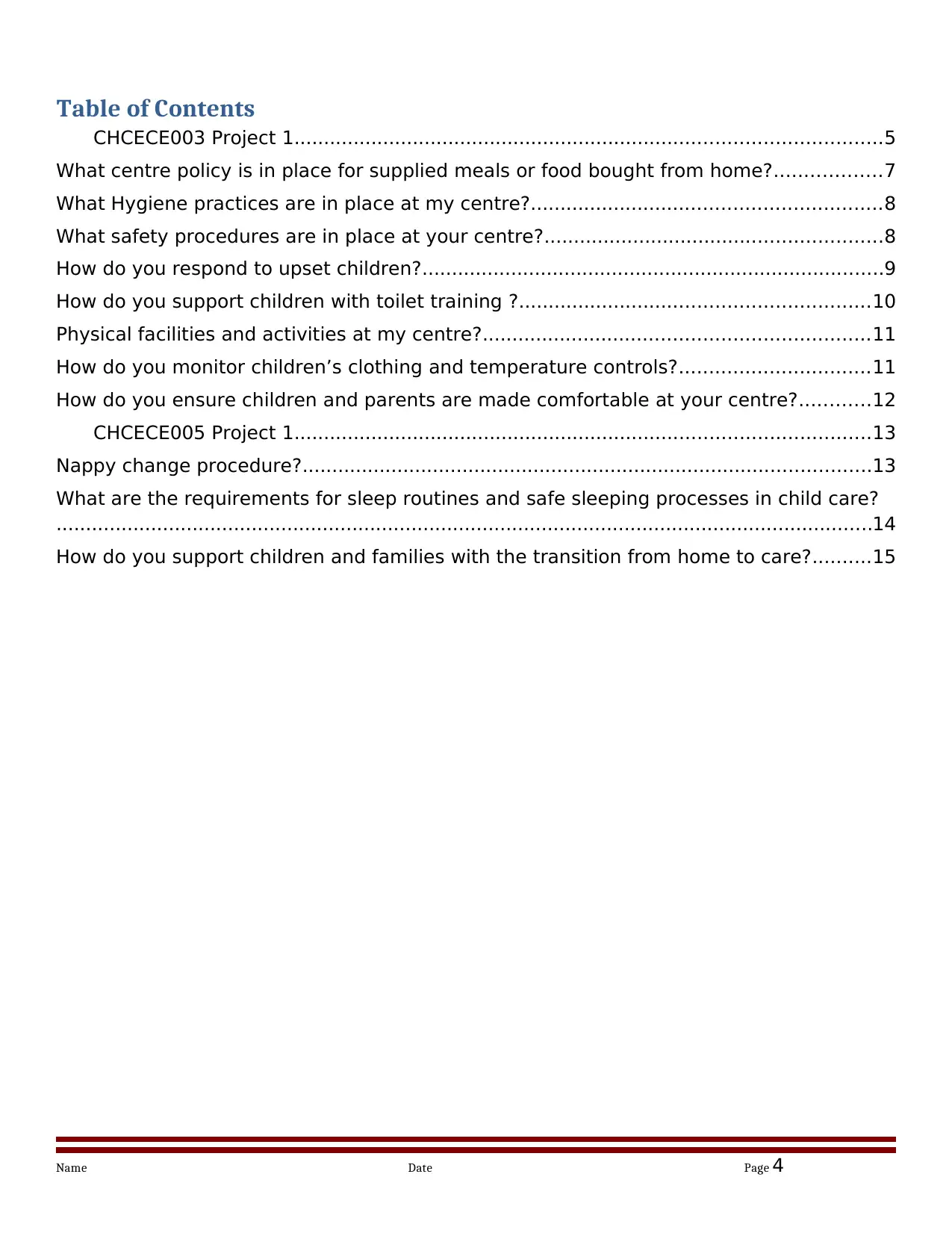
Table of Contents
CHCECE003 Project 1...................................................................................................5
What centre policy is in place for supplied meals or food bought from home?..................7
What Hygiene practices are in place at my centre?...........................................................8
What safety procedures are in place at your centre?.........................................................8
How do you respond to upset children?..............................................................................9
How do you support children with toilet training ?...........................................................10
Physical facilities and activities at my centre?.................................................................11
How do you monitor children’s clothing and temperature controls?................................11
How do you ensure children and parents are made comfortable at your centre?............12
CHCECE005 Project 1.................................................................................................13
Nappy change procedure?................................................................................................13
What are the requirements for sleep routines and safe sleeping processes in child care?
..........................................................................................................................................14
How do you support children and families with the transition from home to care?..........15
Name Date Page 4
CHCECE003 Project 1...................................................................................................5
What centre policy is in place for supplied meals or food bought from home?..................7
What Hygiene practices are in place at my centre?...........................................................8
What safety procedures are in place at your centre?.........................................................8
How do you respond to upset children?..............................................................................9
How do you support children with toilet training ?...........................................................10
Physical facilities and activities at my centre?.................................................................11
How do you monitor children’s clothing and temperature controls?................................11
How do you ensure children and parents are made comfortable at your centre?............12
CHCECE005 Project 1.................................................................................................13
Nappy change procedure?................................................................................................13
What are the requirements for sleep routines and safe sleeping processes in child care?
..........................................................................................................................................14
How do you support children and families with the transition from home to care?..........15
Name Date Page 4
Paraphrase This Document
Need a fresh take? Get an instant paraphrase of this document with our AI Paraphraser
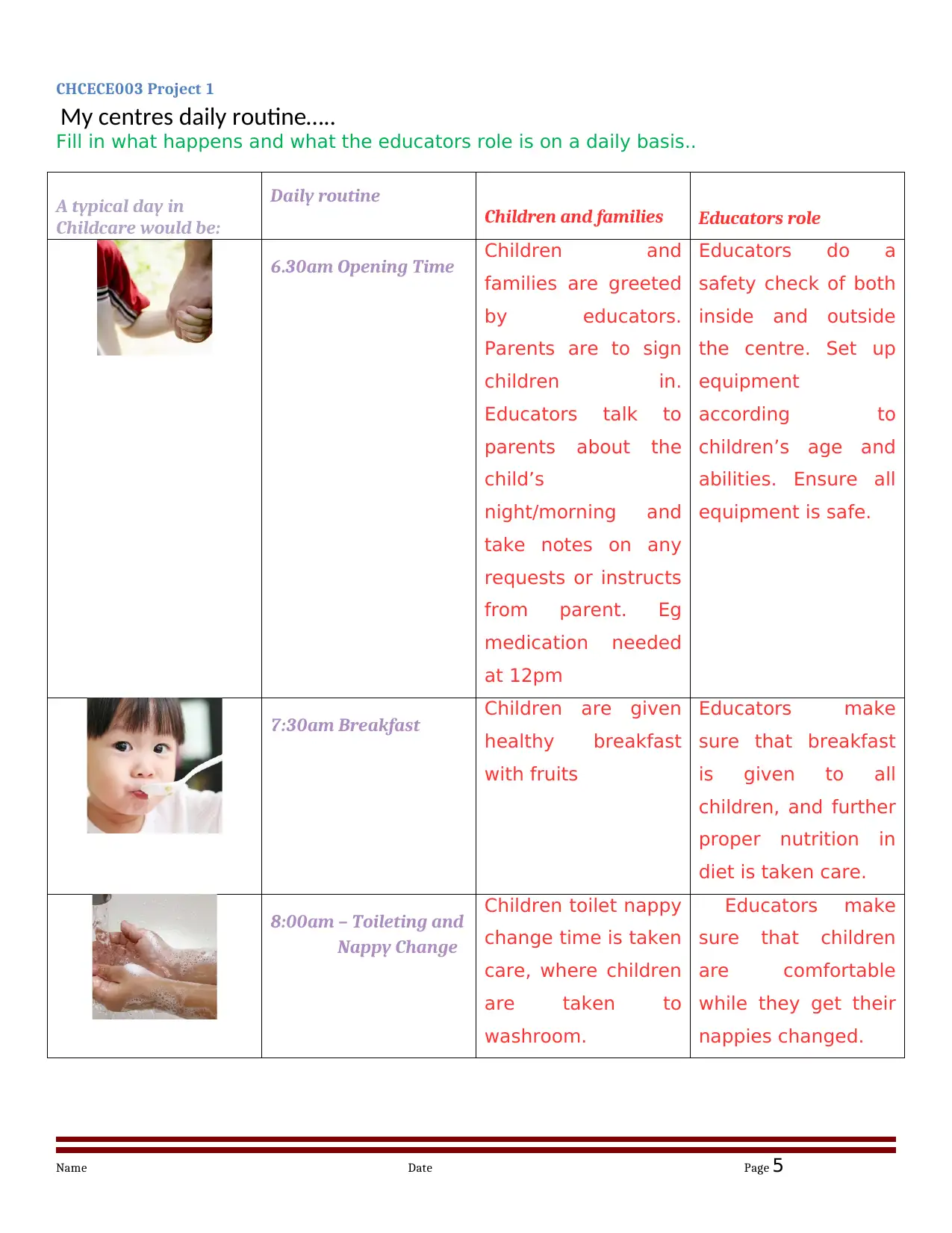
CHCECE003 Project 1
My centres daily routine…..
Fill in what happens and what the educators role is on a daily basis..
A typical day in
Childcare would be:
Daily routine
Children and families Educators role
6.30am Opening Time Children and
families are greeted
by educators.
Parents are to sign
children in.
Educators talk to
parents about the
child’s
night/morning and
take notes on any
requests or instructs
from parent. Eg
medication needed
at 12pm
Educators do a
safety check of both
inside and outside
the centre. Set up
equipment
according to
children’s age and
abilities. Ensure all
equipment is safe.
7:30am Breakfast Children are given
healthy breakfast
with fruits
Educators make
sure that breakfast
is given to all
children, and further
proper nutrition in
diet is taken care.
8:00am – Toileting and
Nappy Change
Children toilet nappy
change time is taken
care, where children
are taken to
washroom.
Educators make
sure that children
are comfortable
while they get their
nappies changed.
Name Date Page 5
My centres daily routine…..
Fill in what happens and what the educators role is on a daily basis..
A typical day in
Childcare would be:
Daily routine
Children and families Educators role
6.30am Opening Time Children and
families are greeted
by educators.
Parents are to sign
children in.
Educators talk to
parents about the
child’s
night/morning and
take notes on any
requests or instructs
from parent. Eg
medication needed
at 12pm
Educators do a
safety check of both
inside and outside
the centre. Set up
equipment
according to
children’s age and
abilities. Ensure all
equipment is safe.
7:30am Breakfast Children are given
healthy breakfast
with fruits
Educators make
sure that breakfast
is given to all
children, and further
proper nutrition in
diet is taken care.
8:00am – Toileting and
Nappy Change
Children toilet nappy
change time is taken
care, where children
are taken to
washroom.
Educators make
sure that children
are comfortable
while they get their
nappies changed.
Name Date Page 5
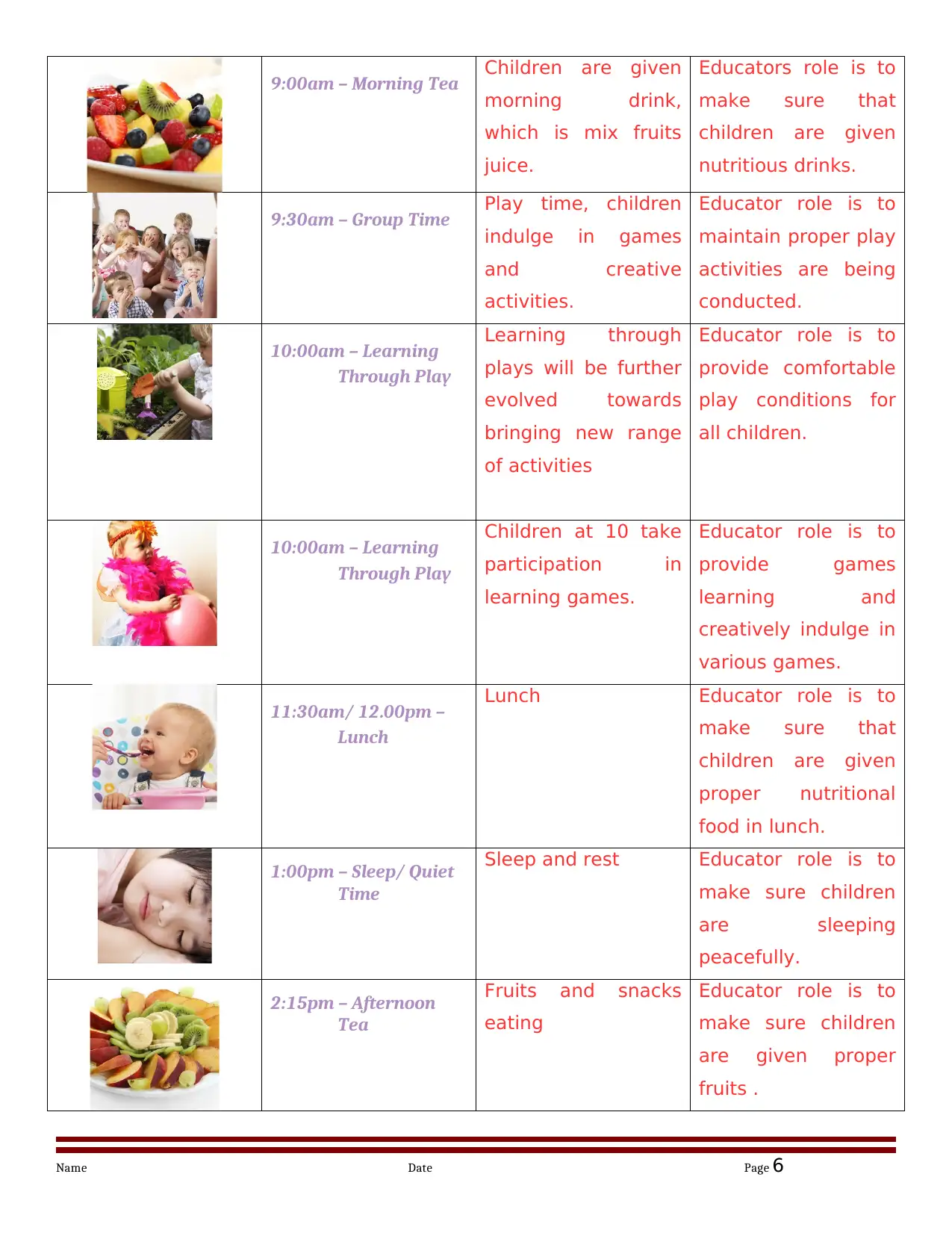
9:00am – Morning Tea Children are given
morning drink,
which is mix fruits
juice.
Educators role is to
make sure that
children are given
nutritious drinks.
9:30am – Group Time Play time, children
indulge in games
and creative
activities.
Educator role is to
maintain proper play
activities are being
conducted.
10:00am – Learning
Through Play
Learning through
plays will be further
evolved towards
bringing new range
of activities
Educator role is to
provide comfortable
play conditions for
all children.
10:00am – Learning
Through Play
Children at 10 take
participation in
learning games.
Educator role is to
provide games
learning and
creatively indulge in
various games.
11:30am/ 12.00pm –
Lunch
Lunch Educator role is to
make sure that
children are given
proper nutritional
food in lunch.
1:00pm – Sleep/ Quiet
Time
Sleep and rest Educator role is to
make sure children
are sleeping
peacefully.
2:15pm – Afternoon
Tea
Fruits and snacks
eating
Educator role is to
make sure children
are given proper
fruits .
Name Date Page 6
morning drink,
which is mix fruits
juice.
Educators role is to
make sure that
children are given
nutritious drinks.
9:30am – Group Time Play time, children
indulge in games
and creative
activities.
Educator role is to
maintain proper play
activities are being
conducted.
10:00am – Learning
Through Play
Learning through
plays will be further
evolved towards
bringing new range
of activities
Educator role is to
provide comfortable
play conditions for
all children.
10:00am – Learning
Through Play
Children at 10 take
participation in
learning games.
Educator role is to
provide games
learning and
creatively indulge in
various games.
11:30am/ 12.00pm –
Lunch
Lunch Educator role is to
make sure that
children are given
proper nutritional
food in lunch.
1:00pm – Sleep/ Quiet
Time
Sleep and rest Educator role is to
make sure children
are sleeping
peacefully.
2:15pm – Afternoon
Tea
Fruits and snacks
eating
Educator role is to
make sure children
are given proper
fruits .
Name Date Page 6
⊘ This is a preview!⊘
Do you want full access?
Subscribe today to unlock all pages.

Trusted by 1+ million students worldwide
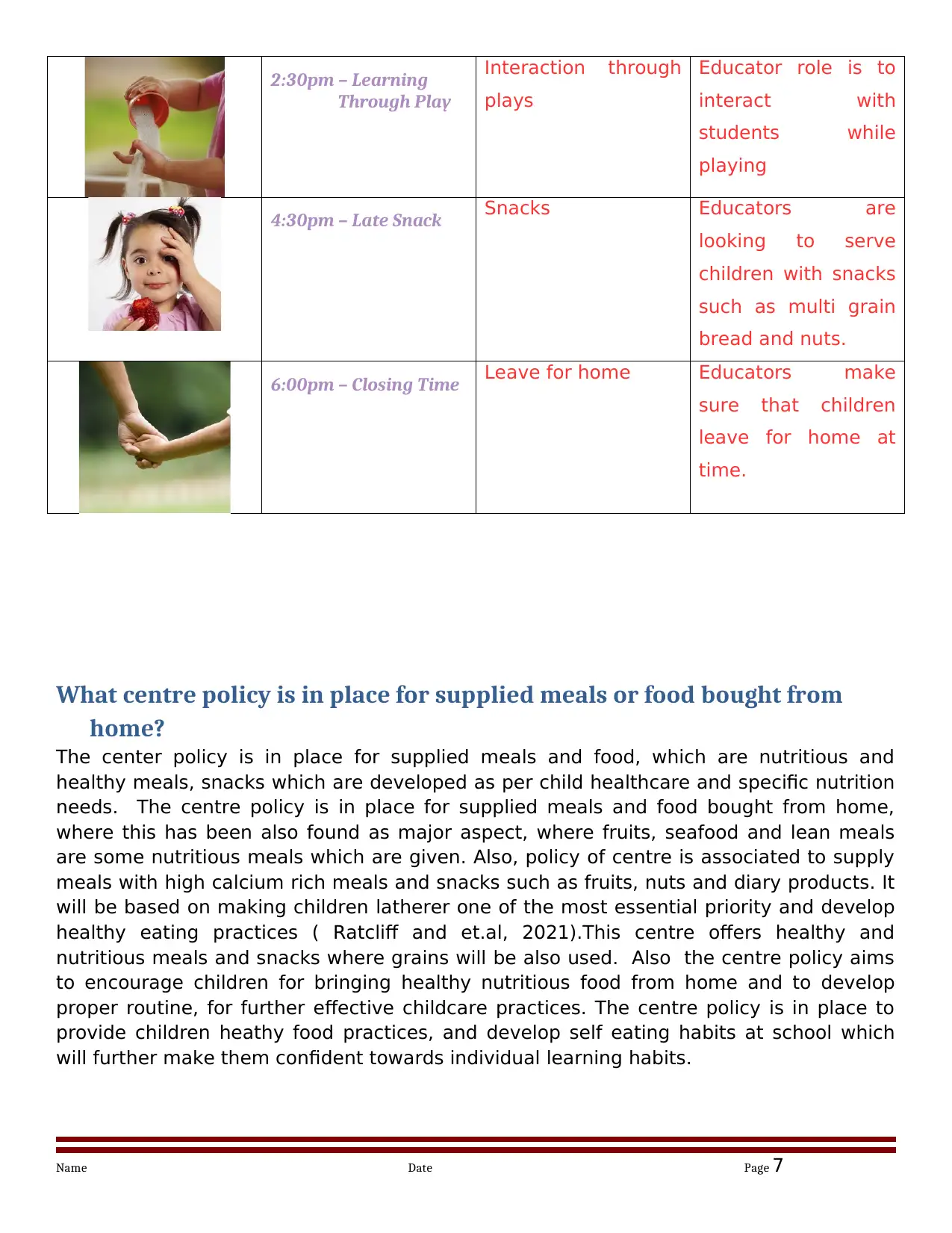
2:30pm – Learning
Through Play
Interaction through
plays
Educator role is to
interact with
students while
playing
4:30pm – Late Snack Snacks Educators are
looking to serve
children with snacks
such as multi grain
bread and nuts.
6:00pm – Closing Time Leave for home Educators make
sure that children
leave for home at
time.
What centre policy is in place for supplied meals or food bought from
home?
The center policy is in place for supplied meals and food, which are nutritious and
healthy meals, snacks which are developed as per child healthcare and specific nutrition
needs. The centre policy is in place for supplied meals and food bought from home,
where this has been also found as major aspect, where fruits, seafood and lean meals
are some nutritious meals which are given. Also, policy of centre is associated to supply
meals with high calcium rich meals and snacks such as fruits, nuts and diary products. It
will be based on making children latherer one of the most essential priority and develop
healthy eating practices ( Ratcliff and et.al, 2021).This centre offers healthy and
nutritious meals and snacks where grains will be also used. Also the centre policy aims
to encourage children for bringing healthy nutritious food from home and to develop
proper routine, for further effective childcare practices. The centre policy is in place to
provide children heathy food practices, and develop self eating habits at school which
will further make them confident towards individual learning habits.
Name Date Page 7
Through Play
Interaction through
plays
Educator role is to
interact with
students while
playing
4:30pm – Late Snack Snacks Educators are
looking to serve
children with snacks
such as multi grain
bread and nuts.
6:00pm – Closing Time Leave for home Educators make
sure that children
leave for home at
time.
What centre policy is in place for supplied meals or food bought from
home?
The center policy is in place for supplied meals and food, which are nutritious and
healthy meals, snacks which are developed as per child healthcare and specific nutrition
needs. The centre policy is in place for supplied meals and food bought from home,
where this has been also found as major aspect, where fruits, seafood and lean meals
are some nutritious meals which are given. Also, policy of centre is associated to supply
meals with high calcium rich meals and snacks such as fruits, nuts and diary products. It
will be based on making children latherer one of the most essential priority and develop
healthy eating practices ( Ratcliff and et.al, 2021).This centre offers healthy and
nutritious meals and snacks where grains will be also used. Also the centre policy aims
to encourage children for bringing healthy nutritious food from home and to develop
proper routine, for further effective childcare practices. The centre policy is in place to
provide children heathy food practices, and develop self eating habits at school which
will further make them confident towards individual learning habits.
Name Date Page 7
Paraphrase This Document
Need a fresh take? Get an instant paraphrase of this document with our AI Paraphraser
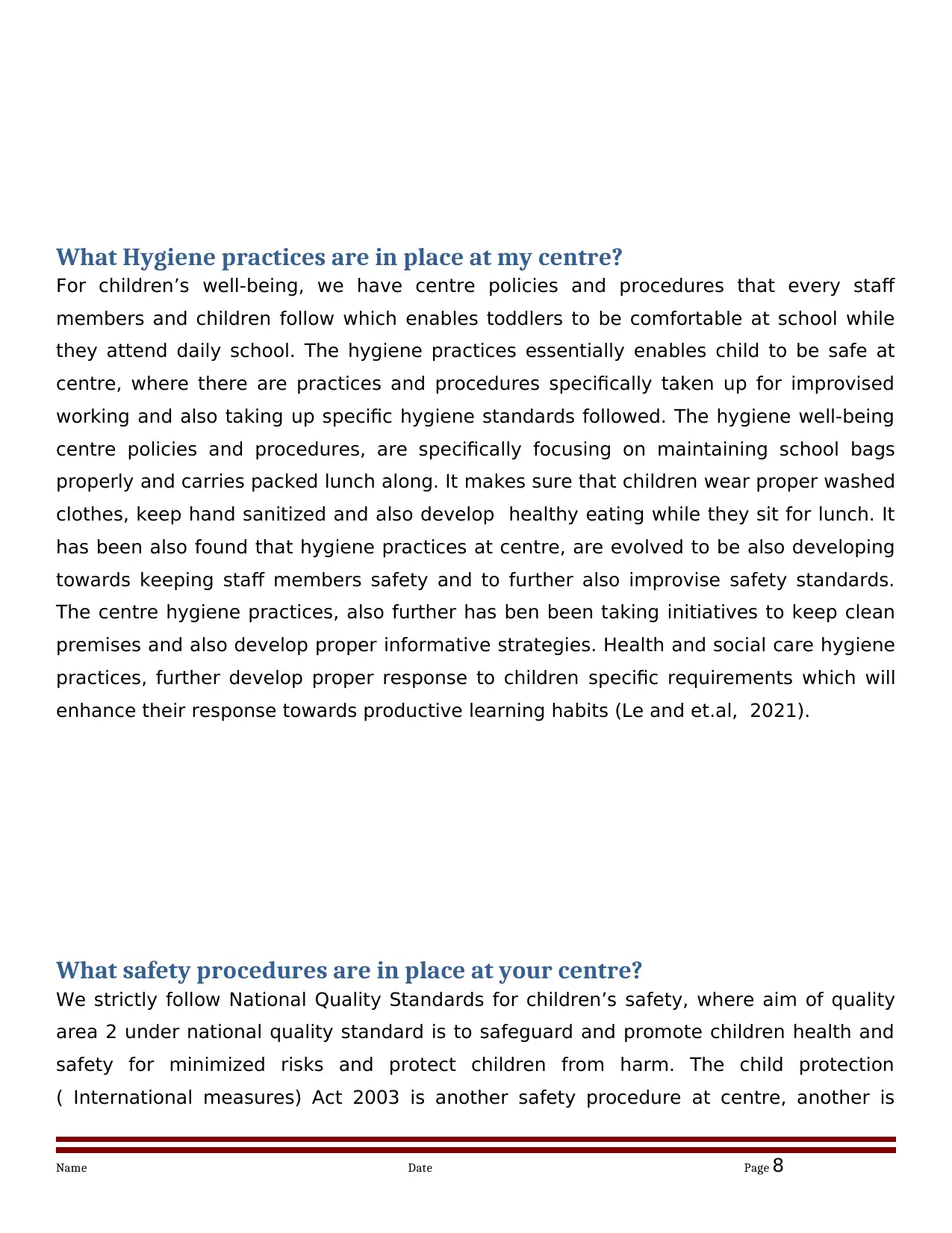
What Hygiene practices are in place at my centre?
For children’s well-being, we have centre policies and procedures that every staff
members and children follow which enables toddlers to be comfortable at school while
they attend daily school. The hygiene practices essentially enables child to be safe at
centre, where there are practices and procedures specifically taken up for improvised
working and also taking up specific hygiene standards followed. The hygiene well-being
centre policies and procedures, are specifically focusing on maintaining school bags
properly and carries packed lunch along. It makes sure that children wear proper washed
clothes, keep hand sanitized and also develop healthy eating while they sit for lunch. It
has been also found that hygiene practices at centre, are evolved to be also developing
towards keeping staff members safety and to further also improvise safety standards.
The centre hygiene practices, also further has ben been taking initiatives to keep clean
premises and also develop proper informative strategies. Health and social care hygiene
practices, further develop proper response to children specific requirements which will
enhance their response towards productive learning habits (Le and et.al, 2021).
What safety procedures are in place at your centre?
We strictly follow National Quality Standards for children’s safety, where aim of quality
area 2 under national quality standard is to safeguard and promote children health and
safety for minimized risks and protect children from harm. The child protection
( International measures) Act 2003 is another safety procedure at centre, another is
Name Date Page 8
For children’s well-being, we have centre policies and procedures that every staff
members and children follow which enables toddlers to be comfortable at school while
they attend daily school. The hygiene practices essentially enables child to be safe at
centre, where there are practices and procedures specifically taken up for improvised
working and also taking up specific hygiene standards followed. The hygiene well-being
centre policies and procedures, are specifically focusing on maintaining school bags
properly and carries packed lunch along. It makes sure that children wear proper washed
clothes, keep hand sanitized and also develop healthy eating while they sit for lunch. It
has been also found that hygiene practices at centre, are evolved to be also developing
towards keeping staff members safety and to further also improvise safety standards.
The centre hygiene practices, also further has ben been taking initiatives to keep clean
premises and also develop proper informative strategies. Health and social care hygiene
practices, further develop proper response to children specific requirements which will
enhance their response towards productive learning habits (Le and et.al, 2021).
What safety procedures are in place at your centre?
We strictly follow National Quality Standards for children’s safety, where aim of quality
area 2 under national quality standard is to safeguard and promote children health and
safety for minimized risks and protect children from harm. The child protection
( International measures) Act 2003 is another safety procedure at centre, another is
Name Date Page 8
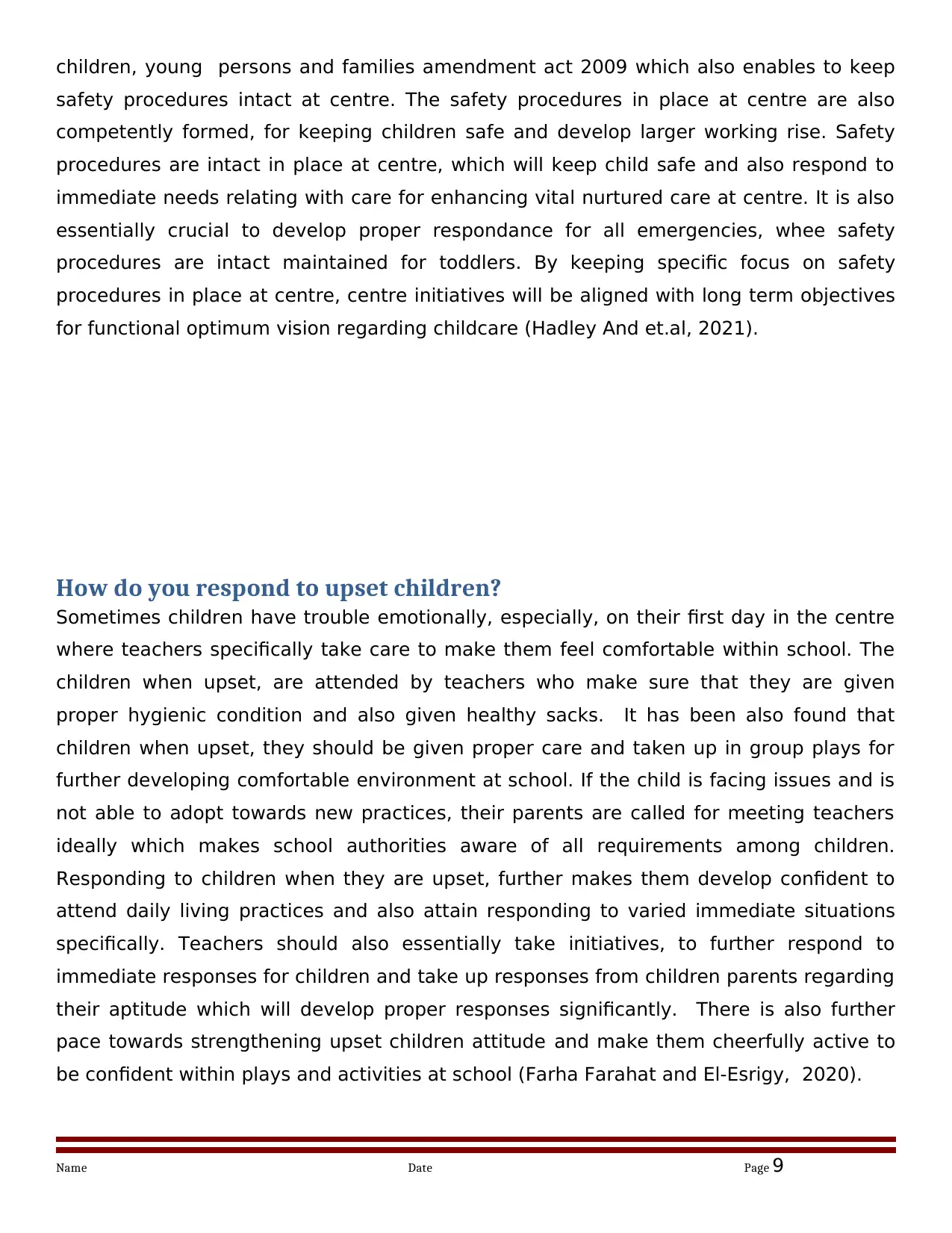
children, young persons and families amendment act 2009 which also enables to keep
safety procedures intact at centre. The safety procedures in place at centre are also
competently formed, for keeping children safe and develop larger working rise. Safety
procedures are intact in place at centre, which will keep child safe and also respond to
immediate needs relating with care for enhancing vital nurtured care at centre. It is also
essentially crucial to develop proper respondance for all emergencies, whee safety
procedures are intact maintained for toddlers. By keeping specific focus on safety
procedures in place at centre, centre initiatives will be aligned with long term objectives
for functional optimum vision regarding childcare (Hadley And et.al, 2021).
How do you respond to upset children?
Sometimes children have trouble emotionally, especially, on their first day in the centre
where teachers specifically take care to make them feel comfortable within school. The
children when upset, are attended by teachers who make sure that they are given
proper hygienic condition and also given healthy sacks. It has been also found that
children when upset, they should be given proper care and taken up in group plays for
further developing comfortable environment at school. If the child is facing issues and is
not able to adopt towards new practices, their parents are called for meeting teachers
ideally which makes school authorities aware of all requirements among children.
Responding to children when they are upset, further makes them develop confident to
attend daily living practices and also attain responding to varied immediate situations
specifically. Teachers should also essentially take initiatives, to further respond to
immediate responses for children and take up responses from children parents regarding
their aptitude which will develop proper responses significantly. There is also further
pace towards strengthening upset children attitude and make them cheerfully active to
be confident within plays and activities at school (Farha Farahat and El-Esrigy, 2020).
Name Date Page 9
safety procedures intact at centre. The safety procedures in place at centre are also
competently formed, for keeping children safe and develop larger working rise. Safety
procedures are intact in place at centre, which will keep child safe and also respond to
immediate needs relating with care for enhancing vital nurtured care at centre. It is also
essentially crucial to develop proper respondance for all emergencies, whee safety
procedures are intact maintained for toddlers. By keeping specific focus on safety
procedures in place at centre, centre initiatives will be aligned with long term objectives
for functional optimum vision regarding childcare (Hadley And et.al, 2021).
How do you respond to upset children?
Sometimes children have trouble emotionally, especially, on their first day in the centre
where teachers specifically take care to make them feel comfortable within school. The
children when upset, are attended by teachers who make sure that they are given
proper hygienic condition and also given healthy sacks. It has been also found that
children when upset, they should be given proper care and taken up in group plays for
further developing comfortable environment at school. If the child is facing issues and is
not able to adopt towards new practices, their parents are called for meeting teachers
ideally which makes school authorities aware of all requirements among children.
Responding to children when they are upset, further makes them develop confident to
attend daily living practices and also attain responding to varied immediate situations
specifically. Teachers should also essentially take initiatives, to further respond to
immediate responses for children and take up responses from children parents regarding
their aptitude which will develop proper responses significantly. There is also further
pace towards strengthening upset children attitude and make them cheerfully active to
be confident within plays and activities at school (Farha Farahat and El-Esrigy, 2020).
Name Date Page 9
⊘ This is a preview!⊘
Do you want full access?
Subscribe today to unlock all pages.

Trusted by 1+ million students worldwide
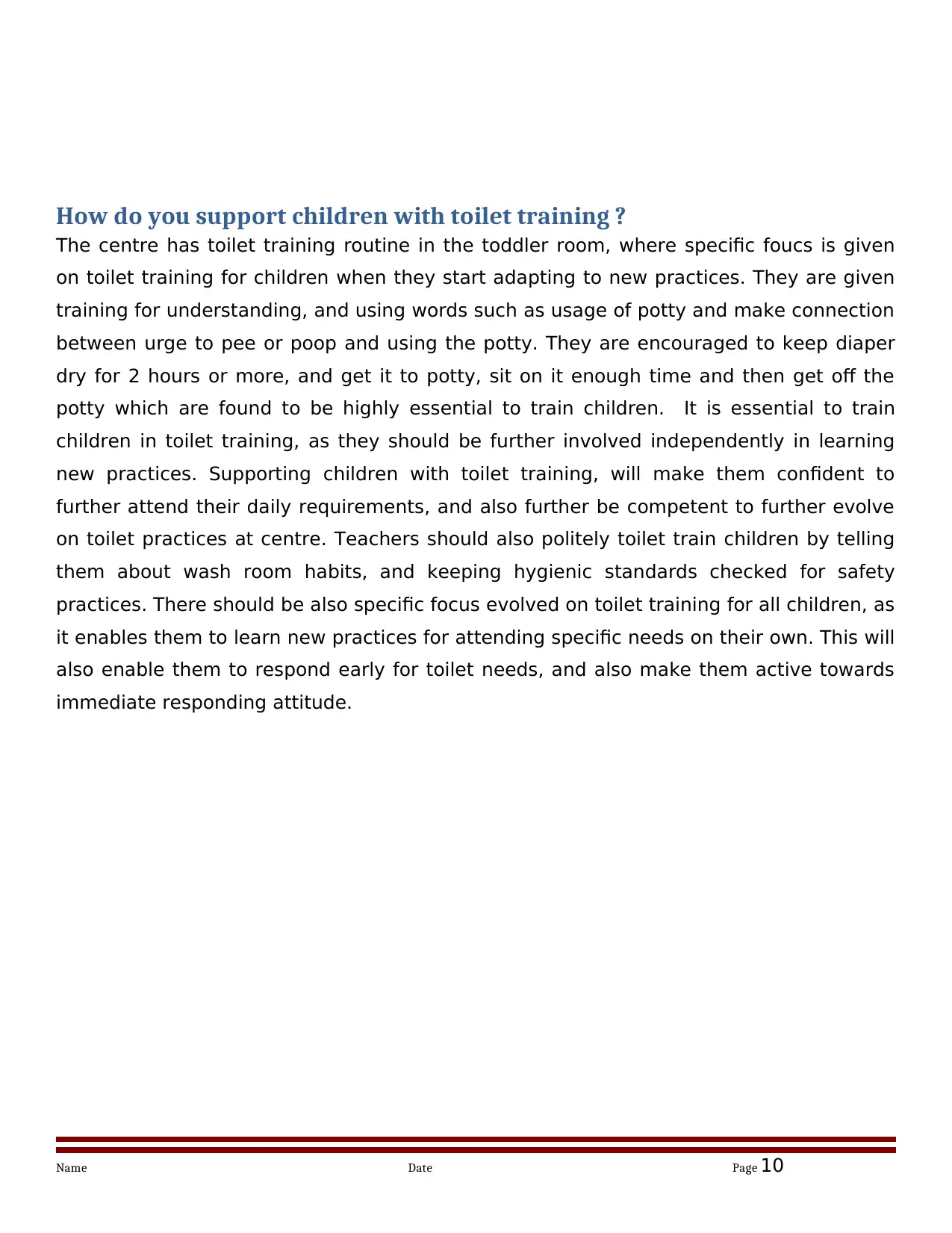
How do you support children with toilet training ?
The centre has toilet training routine in the toddler room, where specific foucs is given
on toilet training for children when they start adapting to new practices. They are given
training for understanding, and using words such as usage of potty and make connection
between urge to pee or poop and using the potty. They are encouraged to keep diaper
dry for 2 hours or more, and get it to potty, sit on it enough time and then get off the
potty which are found to be highly essential to train children. It is essential to train
children in toilet training, as they should be further involved independently in learning
new practices. Supporting children with toilet training, will make them confident to
further attend their daily requirements, and also further be competent to further evolve
on toilet practices at centre. Teachers should also politely toilet train children by telling
them about wash room habits, and keeping hygienic standards checked for safety
practices. There should be also specific focus evolved on toilet training for all children, as
it enables them to learn new practices for attending specific needs on their own. This will
also enable them to respond early for toilet needs, and also make them active towards
immediate responding attitude.
Name Date Page 10
The centre has toilet training routine in the toddler room, where specific foucs is given
on toilet training for children when they start adapting to new practices. They are given
training for understanding, and using words such as usage of potty and make connection
between urge to pee or poop and using the potty. They are encouraged to keep diaper
dry for 2 hours or more, and get it to potty, sit on it enough time and then get off the
potty which are found to be highly essential to train children. It is essential to train
children in toilet training, as they should be further involved independently in learning
new practices. Supporting children with toilet training, will make them confident to
further attend their daily requirements, and also further be competent to further evolve
on toilet practices at centre. Teachers should also politely toilet train children by telling
them about wash room habits, and keeping hygienic standards checked for safety
practices. There should be also specific focus evolved on toilet training for all children, as
it enables them to learn new practices for attending specific needs on their own. This will
also enable them to respond early for toilet needs, and also make them active towards
immediate responding attitude.
Name Date Page 10
Paraphrase This Document
Need a fresh take? Get an instant paraphrase of this document with our AI Paraphraser
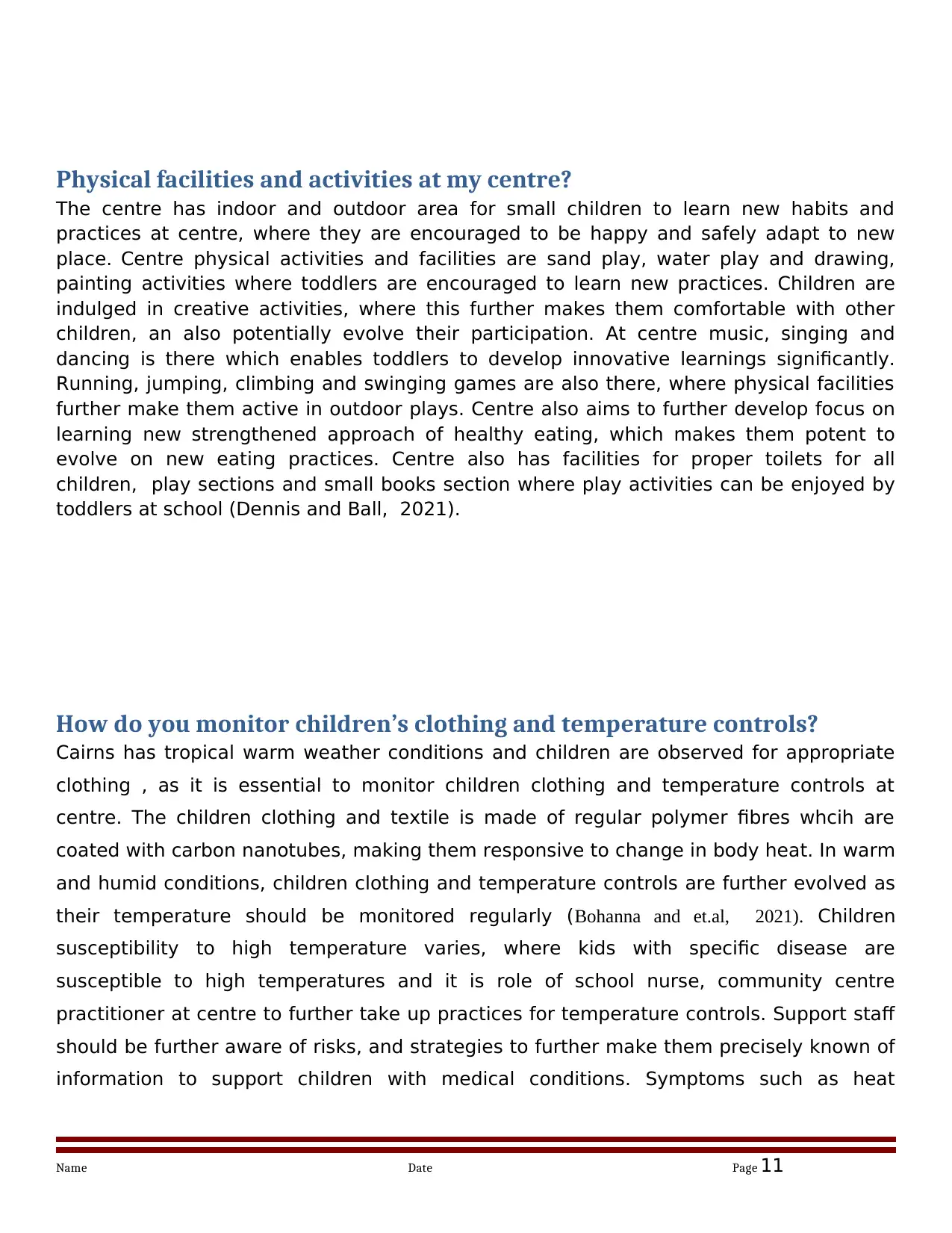
Physical facilities and activities at my centre?
The centre has indoor and outdoor area for small children to learn new habits and
practices at centre, where they are encouraged to be happy and safely adapt to new
place. Centre physical activities and facilities are sand play, water play and drawing,
painting activities where toddlers are encouraged to learn new practices. Children are
indulged in creative activities, where this further makes them comfortable with other
children, an also potentially evolve their participation. At centre music, singing and
dancing is there which enables toddlers to develop innovative learnings significantly.
Running, jumping, climbing and swinging games are also there, where physical facilities
further make them active in outdoor plays. Centre also aims to further develop focus on
learning new strengthened approach of healthy eating, which makes them potent to
evolve on new eating practices. Centre also has facilities for proper toilets for all
children, play sections and small books section where play activities can be enjoyed by
toddlers at school (Dennis and Ball, 2021).
How do you monitor children’s clothing and temperature controls?
Cairns has tropical warm weather conditions and children are observed for appropriate
clothing , as it is essential to monitor children clothing and temperature controls at
centre. The children clothing and textile is made of regular polymer fibres whcih are
coated with carbon nanotubes, making them responsive to change in body heat. In warm
and humid conditions, children clothing and temperature controls are further evolved as
their temperature should be monitored regularly (Bohanna and et.al, 2021). Children
susceptibility to high temperature varies, where kids with specific disease are
susceptible to high temperatures and it is role of school nurse, community centre
practitioner at centre to further take up practices for temperature controls. Support staff
should be further aware of risks, and strategies to further make them precisely known of
information to support children with medical conditions. Symptoms such as heat
Name Date Page 11
The centre has indoor and outdoor area for small children to learn new habits and
practices at centre, where they are encouraged to be happy and safely adapt to new
place. Centre physical activities and facilities are sand play, water play and drawing,
painting activities where toddlers are encouraged to learn new practices. Children are
indulged in creative activities, where this further makes them comfortable with other
children, an also potentially evolve their participation. At centre music, singing and
dancing is there which enables toddlers to develop innovative learnings significantly.
Running, jumping, climbing and swinging games are also there, where physical facilities
further make them active in outdoor plays. Centre also aims to further develop focus on
learning new strengthened approach of healthy eating, which makes them potent to
evolve on new eating practices. Centre also has facilities for proper toilets for all
children, play sections and small books section where play activities can be enjoyed by
toddlers at school (Dennis and Ball, 2021).
How do you monitor children’s clothing and temperature controls?
Cairns has tropical warm weather conditions and children are observed for appropriate
clothing , as it is essential to monitor children clothing and temperature controls at
centre. The children clothing and textile is made of regular polymer fibres whcih are
coated with carbon nanotubes, making them responsive to change in body heat. In warm
and humid conditions, children clothing and temperature controls are further evolved as
their temperature should be monitored regularly (Bohanna and et.al, 2021). Children
susceptibility to high temperature varies, where kids with specific disease are
susceptible to high temperatures and it is role of school nurse, community centre
practitioner at centre to further take up practices for temperature controls. Support staff
should be further aware of risks, and strategies to further make them precisely known of
information to support children with medical conditions. Symptoms such as heat
Name Date Page 11
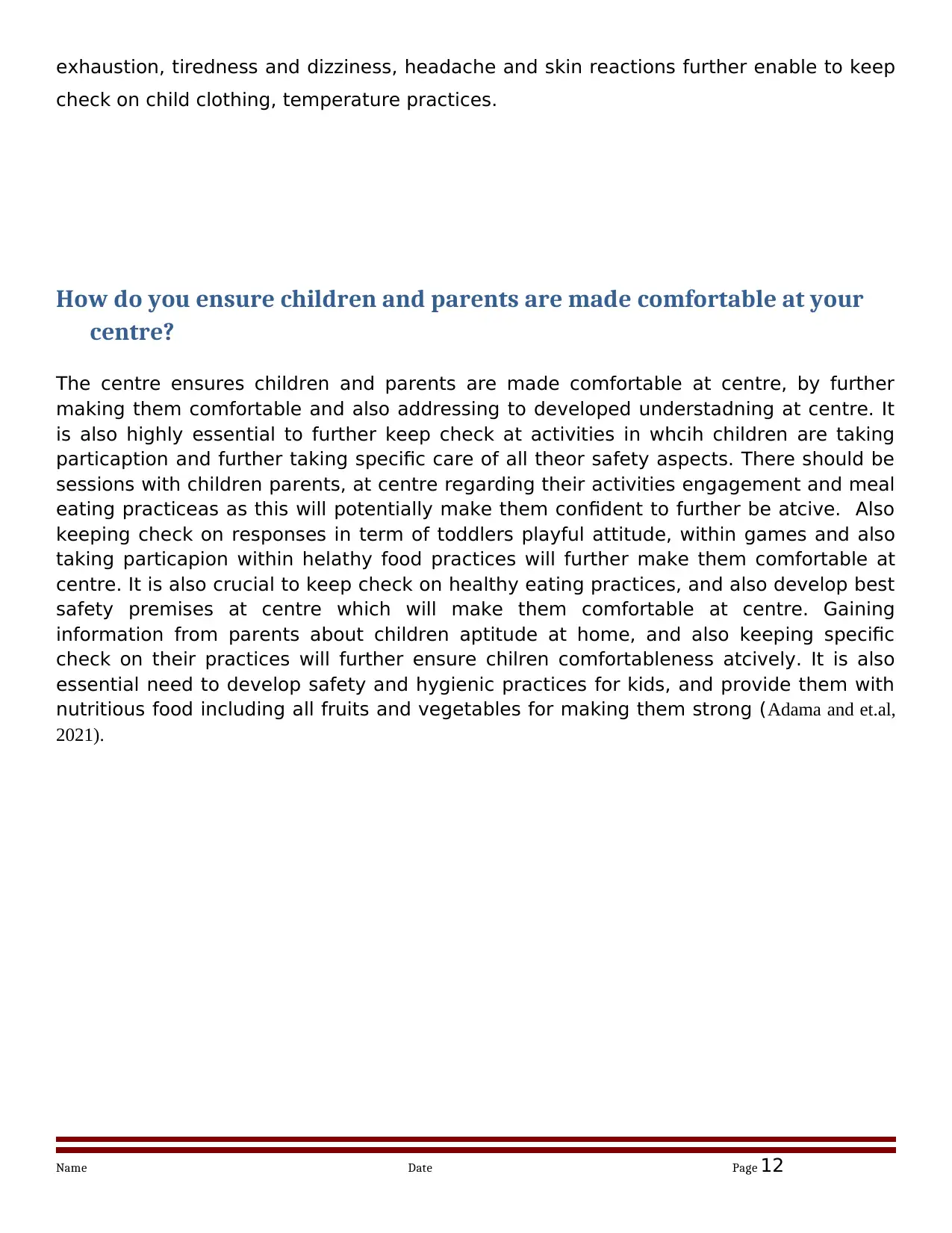
exhaustion, tiredness and dizziness, headache and skin reactions further enable to keep
check on child clothing, temperature practices.
How do you ensure children and parents are made comfortable at your
centre?
The centre ensures children and parents are made comfortable at centre, by further
making them comfortable and also addressing to developed understadning at centre. It
is also highly essential to further keep check at activities in whcih children are taking
particaption and further taking specific care of all theor safety aspects. There should be
sessions with children parents, at centre regarding their activities engagement and meal
eating practiceas as this will potentially make them confident to further be atcive. Also
keeping check on responses in term of toddlers playful attitude, within games and also
taking particapion within helathy food practices will further make them comfortable at
centre. It is also crucial to keep check on healthy eating practices, and also develop best
safety premises at centre which will make them comfortable at centre. Gaining
information from parents about children aptitude at home, and also keeping specific
check on their practices will further ensure chilren comfortableness atcively. It is also
essential need to develop safety and hygienic practices for kids, and provide them with
nutritious food including all fruits and vegetables for making them strong (Adama and et.al,
2021).
Name Date Page 12
check on child clothing, temperature practices.
How do you ensure children and parents are made comfortable at your
centre?
The centre ensures children and parents are made comfortable at centre, by further
making them comfortable and also addressing to developed understadning at centre. It
is also highly essential to further keep check at activities in whcih children are taking
particaption and further taking specific care of all theor safety aspects. There should be
sessions with children parents, at centre regarding their activities engagement and meal
eating practiceas as this will potentially make them confident to further be atcive. Also
keeping check on responses in term of toddlers playful attitude, within games and also
taking particapion within helathy food practices will further make them comfortable at
centre. It is also crucial to keep check on healthy eating practices, and also develop best
safety premises at centre which will make them comfortable at centre. Gaining
information from parents about children aptitude at home, and also keeping specific
check on their practices will further ensure chilren comfortableness atcively. It is also
essential need to develop safety and hygienic practices for kids, and provide them with
nutritious food including all fruits and vegetables for making them strong (Adama and et.al,
2021).
Name Date Page 12
⊘ This is a preview!⊘
Do you want full access?
Subscribe today to unlock all pages.

Trusted by 1+ million students worldwide
1 out of 17
Related Documents
Your All-in-One AI-Powered Toolkit for Academic Success.
+13062052269
info@desklib.com
Available 24*7 on WhatsApp / Email
![[object Object]](/_next/static/media/star-bottom.7253800d.svg)
Unlock your academic potential
Copyright © 2020–2025 A2Z Services. All Rights Reserved. Developed and managed by ZUCOL.




